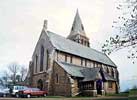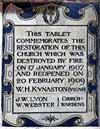 Annesley Annesley
All Saints
History
The present Church of All Saints is part of a long history,
and is probably the fourth church that has stood in the community of Annesley.
There was most likely a Saxon foundation, which was replaced by a Norman church
in the 12th Century. This was itself replaced in the 14th Century with
a church, now Annesley Old Church, built near
to Annesley Hall (rather outside the current village). The ruins of the Old
Church still stand.
The current Victorian Gothic church was built following
the sinking and development of Annesley Colliery, which began in 1865 and led
to the establishment of a new centre of local population (New Annesley) about
a mile and a half to the east of the 1356 Church.
The newcomers soon complained about the distance they had to walk to get to
church and in response the then Vicar, the Revd Clement Howard Prance, together
with the Squire, John Chaworth-Musters and his wife Caroline, resolved to build
a new church.
The land was given by the squire and the architect was Thomas Graham Jackson
of Oxford, a friend of the Revd Mr Prance. The church cost £8350
to build and equip and this sum was funded by the Squire, the Vicar, the Vicar’s
brother, the Vicar’s friends, colliery customers, local contributions,
concerts and sundry collections. In addition, the Squire paid for the hanging
of the bells, five of which were transferred from
the old church, while a sixth was added later.
While building was underway, moves were made to establish a bridgehead of
worship in the colliery community and on 7th January 1873 a licence was granted
by the Bishop of Lincoln to “hold, conduct and celebrate Divine Service”
in a building referred to in the Diocesan document as the Mission Room. This
was a large wooden hut, situated at the back of 15 and 16 Byron Road, which
local people called, rather more prosaically, the Mission Shed.
The New Church was consecrated in 1874, when the hut was sold to the East
Kirkby Methodist Church. Later it passed to the Mansfield Primitive Methodists.
After the new All Saints Church had been brought into use, a description appeared
in The Mansfield and North Notts Advertiser dated 18 August 1876,
as part of a series on The Places of Worship in Mansfield and District. The
following is an extract (note the imprecise information about the bells):
The new church is of very fine proportions. It consists of chancel, nave,
aisles and tower, and is a fine specimen of the pointed style of architecture,
built of stone procured from the quarries of Sutton and Annesley, and dressings
of Ancaster stone. The roof is of Brosely tile. The tower, which is of considerable
height, is a well-proportioned and elegant structure, in which is placed
a peal of six bells, removed from the old church near the Hall. Both externally
and internally the edifice presents an elegant and imposing appearance.
For many years after the New Church opened, the Old Church continued in use.
All the children of John and Caroline Chaworth-Musters were baptised there.
The Annesley Parish Magazine for 1884 had a front cover featuring sketches
of the Old and the New Churches on alternate issues. Harvest Festival Services
continued to be held in the old church in the Park, rather than in the new
church in the colliery village.
 Tiled plaque Tiled plaque
recording the
reopening of
the church in 1909 |
On 17 January 1907 the New Church was badly damaged by
fire which destroyed the roof, bells, interior fittings and organ. At a cost
of some £4750, the church was restored, overwhelmingly to the original
design but with minor changes to the interior. The architects were Evans and
Son of Nottingham and the main contractor was Thomas Fish and Sons. Messrs
Evans, however, advised that the tower could not support traditional bells
and therefore a set of tubular bells was installed. The New Church was reopened
on 20 February 1909.
In 1963, the Parishes of Annesley and Newstead were united, with subsequent
incumbents responsible for Annesley, All Saints; Newstead
Village, St Mary the Virgin; and Newstead Abbey, St Mary.
The Buildings
| Date unknown |
|
The Saxon Church |
 |
| Circa 1150 |
|
The Norman Church |
 |
| 1356 |
|
The “Old Church” |
 |
| 1874 |
|
The “New Church” |
 |
| 1909 |
|
The restored “New Church” |
| 


 Tiled plaque
Tiled plaque 









